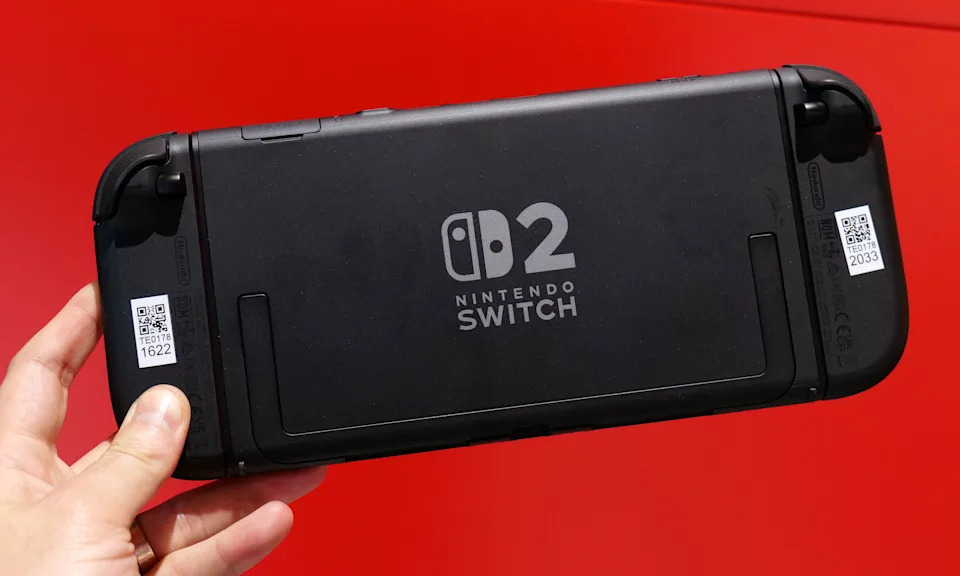
Nintendo Switch 2 Preorder Delay: Invitations May Arrive After Official June Launch
Nintendo Switch 2 Sales Forecast: 15 Million Units Expected in First Fiscal Year
Table of Contents
A render of the upcoming Nintendo Switch 2 console, scheduled for release on June 5th, 2025. (Image: Nintendo)
In a move that has surprised industry analysts, Nintendo’s latest Switch 2 sales forecast projects 15 million units sold during its first fiscal year ending March 2026. This conservative estimate, revealed in the company’s recent earnings report, falls below market expectations despite overwhelming pre-order demand that has left retailers struggling to meet consumer interest in the next-generation gaming device.
Nintendo Switch 2 Sales Forecast: Conservative Approach
The official Nintendo Switch 2 sales forecast of 15 million units for its first year on the market represents a strategic underestimation typical of Nintendo’s cautious approach to financial projections. This figure falls notably short of industry analyst predictions, which had pegged first-year sales at approximately 16.8 million units based on current market demand signals and the impressive legacy of the original Switch.
“Nintendo typically provides conservative guidance that it can beat. The 15 million target looks beatable given the strong pre-orders,” noted Serkan Toto, CEO of game industry consultancy Kantan Games, in response to the Nintendo Switch 2 sales forecast.
While Nintendo didn’t explicitly explain the reasoning behind their modest sales forecast, industry observers point to several potential factors contributing to the company’s cautious stance. Chief among these are concerns surrounding potential U.S. tariffs on imported electronic goods, which could significantly impact pricing and profit margins in Nintendo’s largest market.
Additionally, the company’s history of preferring to exceed financial projections rather than fall short likely plays a role in this conservative Nintendo Switch 2 sales forecast. By setting achievable targets, Nintendo creates an opportunity to report stronger-than-expected performance to shareholders throughout the fiscal year.
Pre-order Demand Exceeding Expectations
Despite the restrained Nintendo Switch 2 sales forecast, actual market demand tells a dramatically different story. Pre-orders for the new console launched with extraordinary momentum, with retailers immediately selling out of their initial allocations. This enthusiastic consumer response has even led Nintendo to issue a warning that its own direct pre-orders may not be fulfilled until after the official June 5th launch date.
Japanese Pre-order Numbers
In Japan alone, Nintendo received an astonishing 2.2 million applications for Switch 2 pre-orders, a figure that the company acknowledged “far exceeds our expectations.” This represents approximately 1.7% of Japan’s entire population attempting to secure the console before launch, signaling extraordinary enthusiasm in Nintendo’s home market.
The overwhelming demand reflected in these pre-order figures seems to contradict the modest Nintendo Switch 2 sales forecast of 15 million units. Industry analysts suggest this disconnect may reflect Nintendo’s concerns about manufacturing capacity and supply chain constraints rather than doubts about market demand for the new console.
The $450 price tag of the Switch 2 has generated some consumer complaints, particularly given the original Switch’s $299 launch price. However, the robust pre-order numbers indicate that the price point hasn’t significantly dampened enthusiasm for the new hardware, making the conservative Nintendo Switch 2 sales forecast appear even more puzzling to some market observers.
Tariff Concerns and Market Uncertainties
One key factor potentially influencing the cautious Nintendo Switch 2 sales forecast involves recent developments in international trade policy. Last month, Nintendo took the unusual step of delaying Switch 2 pre-orders in the United States due to concerns over potential tariffs on electronic goods imported from China, where the company manufactures most of its hardware.
Tariff Impact on Console Pricing
The implementation of new tariffs could force Nintendo to either absorb significant costs—reducing profit margins—or increase the Switch 2’s retail price beyond the already controversial $450 mark. Either scenario could negatively impact the Nintendo Switch 2 sales forecast in the crucial North American market, which represents approximately 40% of Nintendo’s global sales.
This geopolitical uncertainty makes forecasting accurate sales figures particularly challenging, potentially explaining Nintendo’s preference for a conservative estimate that can be adjusted upward if favorable trade conditions prevail. The cautious Nintendo Switch 2 sales forecast may therefore represent a hedge against worst-case scenarios rather than the company’s actual internal expectations.
Nintendo’s decision to delay U.S. pre-orders specifically cited these tariff concerns, indicating that trade policy represents a significant consideration in the company’s strategic planning. This external factor adds an unusual variable to the Nintendo Switch 2 sales forecast that wasn’t present during the original Switch launch in 2017.
Historical Perspective: Comparing to Original Switch
To put the current Nintendo Switch 2 sales forecast in context, it’s valuable to examine the sales trajectory of the original Nintendo Switch. During its first 13 months on the market, the Switch sold approximately 17.79 million units worldwide, establishing it as one of Nintendo’s most successful console launches.
| Console | First Year Sales | Lifetime Sales | Launch Price |
|---|---|---|---|
| Nintendo Switch | 17.79M (13 months) | 150M+ (and counting) | $299 |
| Nintendo Switch 2 | 15M (projected) | TBD | $450 |
| Nintendo Wii | 20.13M (13 months) | 101.63M | $249 |
| Nintendo 3DS | 13.95M (13 months) | 75.94M | $249 |
The current Nintendo Switch 2 sales forecast of 15 million units for its first 12 months represents a slightly slower pace than its predecessor, though the comparison isn’t perfectly parallel given the different market conditions and price points. The original Switch benefited from the release of system-selling titles like “The Legend of Zelda: Breath of the Wild” and “Super Mario Odyssey” in its launch window.
With the original Switch now having sold over 150 million units throughout its eight-year lifespan, Nintendo has established a massive install base of players who may be eager to upgrade to new hardware. This existing ecosystem could potentially help the Switch 2 exceed the conservative sales forecast, particularly if Nintendo leverages backward compatibility features to make the transition appealing to current Switch owners.
Market Analysis and Industry Expectations
The disparity between Nintendo’s official Switch 2 sales forecast and actual market indicators has prompted financial analysts to offer their own assessments of the console’s prospects. Many expect Nintendo to comfortably exceed its stated projection, with some maintaining forecasts closer to 17-18 million units for the first fiscal year.
Context: Current Switch Sales Decline
Nintendo’s need for a successful Switch 2 launch is underscored by the sharp decline in original Switch sales, which dropped 30.3% year-over-year according to the same earnings report. This expected decrease reflects consumer anticipation of the new hardware, with many potential buyers delaying purchases until the Switch 2 becomes available.
The market reaction to Nintendo’s conservative Nintendo Switch 2 sales forecast has been measured, with investors appearing to understand the company’s tendency toward cautious projections. Nintendo’s stock experienced minimal volatility following the announcement, suggesting that the market has largely priced in expectations that exceed the official 15 million unit projection.
Supply chain analysts note that Nintendo’s component orders and manufacturing arrangements suggest preparation for production volumes that could support sales beyond the official Nintendo Switch 2 sales forecast. This behind-the-scenes activity provides further evidence that Nintendo may be publicly underestimating while privately preparing for stronger demand.
Future Outlook for Nintendo’s New Console Generation
Looking beyond the first-year Nintendo Switch 2 sales forecast, the successor to the wildly successful Switch faces both significant opportunities and challenges. The original Switch’s hybrid design revolutionized the console market by blending handheld and home console experiences, a formula the Switch 2 maintains while adding technological improvements.
Key Factors for Switch 2 Success
- Launch Titles: The quality and quantity of games available at or near launch
- Backward Compatibility: The ability to leverage the extensive existing Switch library
- Production Capacity: Nintendo’s ability to meet demand despite global supply chain challenges
- Pricing Strategy: Potential adjustments to the $450 price point depending on market response
- Competitive Landscape: How the Switch 2 positions against PlayStation 5 and Xbox Series consoles
Nintendo faces the challenge of transitioning its enormous Switch user base to new hardware while maintaining software sales momentum. The conservative Nintendo Switch 2 sales forecast may reflect an understanding that this transition will take time, with many existing Switch owners potentially waiting for price drops or more exclusive titles before upgrading.
Industry analysts generally remain bullish on the Switch 2’s long-term prospects despite Nintendo’s conservative initial sales forecast. The unique positioning of Nintendo’s hardware in the market—focusing on innovative gameplay rather than raw technical specifications—has proven resilient through multiple console generations and continues to attract a dedicated consumer base.
Conclusion: Reading Between the Lines
The Nintendo Switch 2 sales forecast of 15 million units for fiscal year 2025-2026 appears deliberately conservative given the overwhelming pre-order demand and the original Switch’s sales history. Nintendo’s cautious projection likely reflects a combination of uncertainty around tariffs, manufacturing capacity concerns, and the company’s traditional preference for exceeding financial targets rather than missing them.
For consumers eager to get their hands on the new console, the disconnect between the modest sales forecast and the intense pre-order demand suggests that Switch 2 units may remain difficult to find at retail for months after the June 5th launch. Nintendo’s warning about its own pre-orders potentially arriving after launch day further signals that demand will outstrip supply in the early months, regardless of the conservative annual sales projection.





